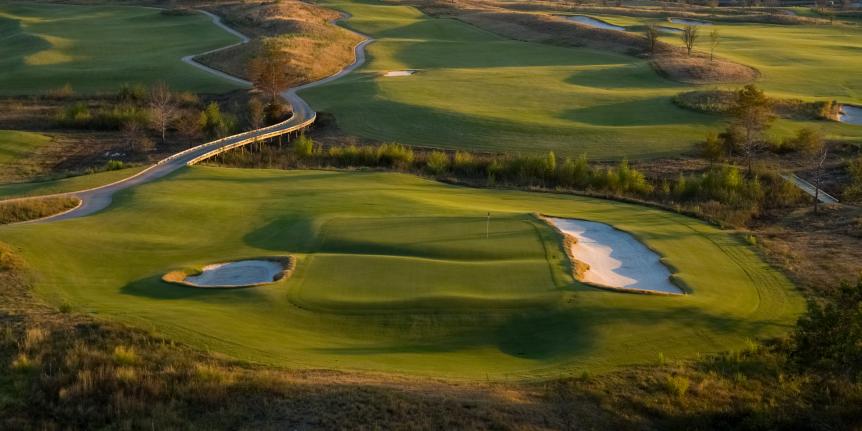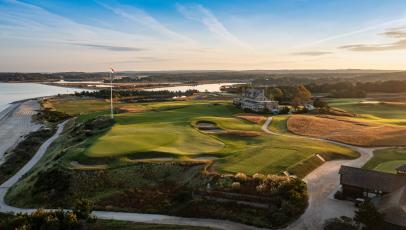BEST NEW
Our team visited 55 new or renovated courses last year. These were the standouts

Each year Golf Digest honors the highest scoring new or remodeled courses in four categories: Best New Public Course, Best New Private Course, Best Renovation (courses that undergo conventional improvements like tree removal, new bunkers, altered tees and expanded or relocated greens) and Best Transformation (courses that are fundamentally remodeled with new or rerouted holes).
Nationally, we had the most course openings since 2010, and an increasing number of courses are undergoing major renovations. Golf Digest panelists visited 55 candidate courses for the 2023 awards (30 Best Renovation candidates and 25 Best New/Best Transformation). Both the quality and quantity of courses are up as the 2023 honorees are an extraordinary lot.
BEST NEW PRIVATE COURSE
Ladera Golf Club, Thermal, Calif.
7,705 yards, par 72
Gil Hanse and Jim Wagner

RUNNERS-UP:
(1) Lost Rail G.C., Gretna, Neb. (below) Scott Hoffman and Landscapes Unlimited
(2) Wicker Point G.C., Alexander City, Ala. Bill Coore and Ben Crenshaw
.jpg.rend.hgtvcom.861.646.suffix/1704312078834.jpeg)
Wicker Point Golf Club
Alexander City, AL, United States
BEST NEW PUBLIC COURSE
The Lido at Sand Valley, Nekoosa, Wis.
7,027 yards, par 72
C.B. Macdonald/Tom Doak
RUNNERS-UP:
(1) Black Desert Resort, Ivins, Utah. Tom Weiskopf and Phil Smith
(2) PGA Frisco, Fields Ranch East, Texas. Gil Hanse and Jim Wagner

(3) PGA Frisco, Fields Ranch West, Texas. Beau Welling

(4) The Park West Palm, West Palm Beach, Fla. Gil Hanse and Jim Wagner
(5) Stillwater G. & C.C., Jacksonville, Fla. Bobby Weed
More from Golf Digest
BEST RENOVATION

SECOND CHANCE Seth Raynor’s original vision for Lookout Mountain finally has been realized.
Lookout Mountain Club (Ga.)
6,701 yards, par 70
Tyler Rae and Kyle Franz
When Seth Raynor passed away unexpectedly in January 1926, he left several courses unfinished and in planning. One of those was Lookout Mountain Club in northwest Georgia. On one hand, it was among Raynor’s greatest sites, sitting hundreds of feet over a valley atop Lookout Mountain with views extending 30 miles or more. On the other, it would have been one of his most challenging: the developer (the club was intended to be an amenity to a luxury hotel and resort) had sited the course on nearly impenetrable volcanic rock.
The job of constructing the course fell to Raynor’s then-associate, Charles Banks. Raynor had drafted his ideas for the holes and their routing but left few details about how to finish them (this was not uncommon for Raynor). Banks did his best, but the extreme cost of blasting through the rock, a 100-year storm that washed away much of the work and a hurricane that nearly bankrupted the Miami-based development company prevented Lookout Mountain from achieving the sophistication associated with Raynor’s better-known courses. In the past 30 years the club engaged several architects, including Brian Silva and Gil Hanse, to develop masterplans to fully implement Raynor’s concepts, but the funding for such comprehensive restoration was never available. Lookout Mountain remained one of golf’s great “what ifs,” with shrunken greens and bunkers that only hinted at brilliance.
A rush of new members and increased play during the COVID pandemic put the club in position to hire architects Tyler Rae and Kyle Franz to finally build the holes that Raynor and Banks couldn’t. The new architects faced many of the old challenges, including the strata of rock beneath the course but were able to use Raynor’s course map as a guide to develop more fully realized versions of holes like Road, Biarritz, Double Plateau and Maiden. To compensate for the lack of instructions regarding green contours, bunker edging or depths, Rae turned to his experience studying dozens of Raynor courses across the United States and used specific holes from several of those designs to guide the shaping.
The architecture of Lookout Mountain fills the immense frame of the site in a way it likely never has before. Removing hundreds of unnecessary and overgrown trees has allowed the enlarged greens, bunkers and rambling fairways to dominate the sightlines, and the views deep into the north Georgia foothills are breathtaking from different points on the property. Most of the greens and bunkers possess recognizable Raynor attributes, but several are surprising in the intensity and character of the contours, including the par-4 third (Sahara), par-5 14th (Lido) and par-3 16th (Eden). The putting surface at the par-4 fifth, called “Dustpan,” is an ocean of rolls and troughs set behind a high-faced bunker that seems more connected to MacKenzie (or Tom Doak), but the inspiration comes from the sixth hole at Raynor’s The Creek in New York.
The design impressively blends subtle sophistication (such as the par-4 first rolling downhill over a crest into a broad green and the wide, gentle Principal’s Nose par-4 eighth playing into a quiet corner) with sheer spectacle (such as the par-3 Redan 13th set against the naked horizon and the par-5 dogleg 10th sweeping uphill and left through a gauntlet of bunkers). The Alps hole 11th, an uphill par 4 with a reveal that can stop golfers in their tracks, should more aptly be named “Matterhorn” for the way the high point behind the punchbowl green aligns with sharp mountain peaks in the distance.
Lookout Mountain now has the course that never got built, but perhaps the biggest success is how Rae and Franz reclaimed the scope and scale of Raynor’s architecture without sacrificing the mysterious mountaintop breaks on the greens that have always been the course’s calling card. It is the fulfillment of a dream deferred.
RUNNERS-UP:
(1) Indian Creek C.C., Fla. Andrew Green (of a William Flynn design)

(2) The Country Club, Cleveland. Gil Hanse and Jim Wagner (William Flynn)

(3) Wampanoag C.C., West Hartford, Conn. Tyler Rae and Kyle Franz, with Brad Klein (Donald Ross)

(4) Maketewah C.C., Cincinnati. Brian Silva (Donald Ross)

(5) Conway Farms G.C., Lake Forest, Ill. David Kahn and Tim Jackson
BEST TRANSFORMATION

RESURRECTED: Lake Merced’s long lost par-3 17th hole was reborn as its new 13th.
Lake Merced Golf Club, Daly City, Calif.
6,915 yards, par 72
Gil Hanse and Jim Wagner
To understand why Hanse and Wagner’s work at Lake Merced was so profound, it’s necessary to understand the course’s complicated history. Lake Merced was founded in 1922 about eight miles south of San Francisco on farmland near the eponymous lake. The first iteration of the course, completed in 1923 by Scottish professional Willie Locke (a year ahead of neighbors Olympic Club and San Francisco Golf Club), was famously punishing with more than 350 bunkers. In 1928 Alister MacKenzie and Robert Hunter were hired to make modifications, namely to re-bunker the course and make it play more strategically.
The MacKenzie/Hunter course existed until the mid-1960s when the construction of Interstate 280 ate into 12 acres along its eastern boundary, forcing San Francisco-based architect Robert Muir Graves to reroute the course and add several new holes on an annexed parcel to the north. Rees Jones retained this configuration during a major 1990s remodel of new greens and bunkers that sat higher above the grade of the land.
Initially brought on for a traditional renovation, Hanse suggested the club consider returning the course to the MacKenzie version. The problem was that I-280 had eliminated a swath of land, and the mature pines and cypress planted in the 1920s now cloaked fairways and clogged old avenues. Reestablishing the MacKenzie routing would require the relocation of the modest driving range that Graves added near the sunken center of the property, with an unsightly net protecting golfers on the 10th hole.
“It became a jigsaw puzzle,” Hanse says. “How do you get all of that back?”
The first step was the removal of hundreds of trees to make space, mostly pines, before the property was stripped down to its base. Hanse and Wagner eliminated Graves’ holes four and five in the gully on the north side of the site and built a new, larger driving range there, now one of the better facilities in the city. That allowed them to reestablish the par-4 sixth hole and par-3 seventh in the old driving range basin where MacKenzie’s seventh and eighth holes had been, and their new par-3 third hole emulates the original, short par-3 fourth. All said, Hanse and Wagner were able to resurrect 14½ MacKenzie holes.
The northwest corner of the course experienced the most significant alterations, including the rebuilt par-4 12th and the reconstruction of one of Lake Merced’s most flamboyant holes, the downhill par-3 13th (it was MacKenzie’s 17th) with a green benched into a hillside surrounded by cloudlike bunkers. The par-3 16th, playing parallel to the 13th in the opposite direction, is an original hole that Hanse created to compensate for the loss of the old first hole with a wide, shallow green that moves balls toward left hole locations.
For all their experience renovating many of the country’s historic courses, Lake Merced is the first Alister MacKenzie course Hanse and Wagner have worked on. Getting the distinct look of the MacKenzie/Hunter northern California bunkering took some practice.
“A lot of MacKenzie’s bunkers laid almost at grade,” Hanse says. “They were in the ground and didn’t have the big, pronounced upsweep we’re more familiar with, so we had to relearn how to shape and build them. There was a lot of head scratching and kicking the dirt, but it was fun, and the golf course really breathes and fits beautifully on that landscape now. It feels right.”
RUNNERS-UP:
(1) Atlanta Athletic Club Riverside Course, Johns Creek, Ga. Tripp Davis
(2) Richland C.C., Nashville. Bill Bergin
(3) Belleair C.C. West Course, Fla. Dana Fry and Jason Straka
(4) Metairie C.C., La. Brian Silva
(5) Broken Sound Club Old Course, Boca Raton, Fla. Rees Jones and Bryce Swanson

Macdonald-Raynor Holes Explained
Alps: A hole with a blind approach over a hill to a punchbowl green fronted with bunkers.
Biarritz: A long par 3 with a deep green featuring high sections separated by a low trough in the center.
Cape: A hole with a green cocked at an angle over bunkers or water, often coupled with a diagonal risk-reward tee shot. Channel: A par 5 with a separate island fairway shortcut separated from the primary fairway by water or sand.
Dog’s Leg: A Lido original referencing a Seth Raynorinspired par 5 that sweeps right around bunkers.
Eden: A par 3 modeled after the 11th at St. Andrews with a wide green sloping back to front above two deep bunkers.
Maiden: The reference to a par 3 at Royal St. George’s now denotes a green with two elevated back mounds divided by a swale.
Home: Original to The Lido, a broad par 4 with multiple avenues of play based on a design by Alister MacKenzie.
Long: A par 5 modeled after the 14th at St. Andrews with a version of the Hell Bunker, which is a formidable carry in the fairway.
Plateau: Short for Double Plateau, a green with three distinct levels, often arranged in different configurations.
Principal’s Nose: An elevated configuration of three bunkers that can resemble a nose and pair of eyes; used at Lookout Mountain to separate left and right fairway paths.
Punchbowl: A green surrounded with high banks that collect shots onto the putting surface.
Redan: A par 3 with an angled green sloping front to back and outside edge to inside edge.
Road: A par 4 or 5 modeled after the 17th at St. Andrews with a deep pot bunker protecting the green and another long bunker or depression behind it.
Sahara: A short par 4 requiring a tee shot across an often-blind hazard to reach the green or set up a clear angle approach.



%20hero.jpg.rend.hgtvcom.406.203.suffix/1620136440329.jpeg)
